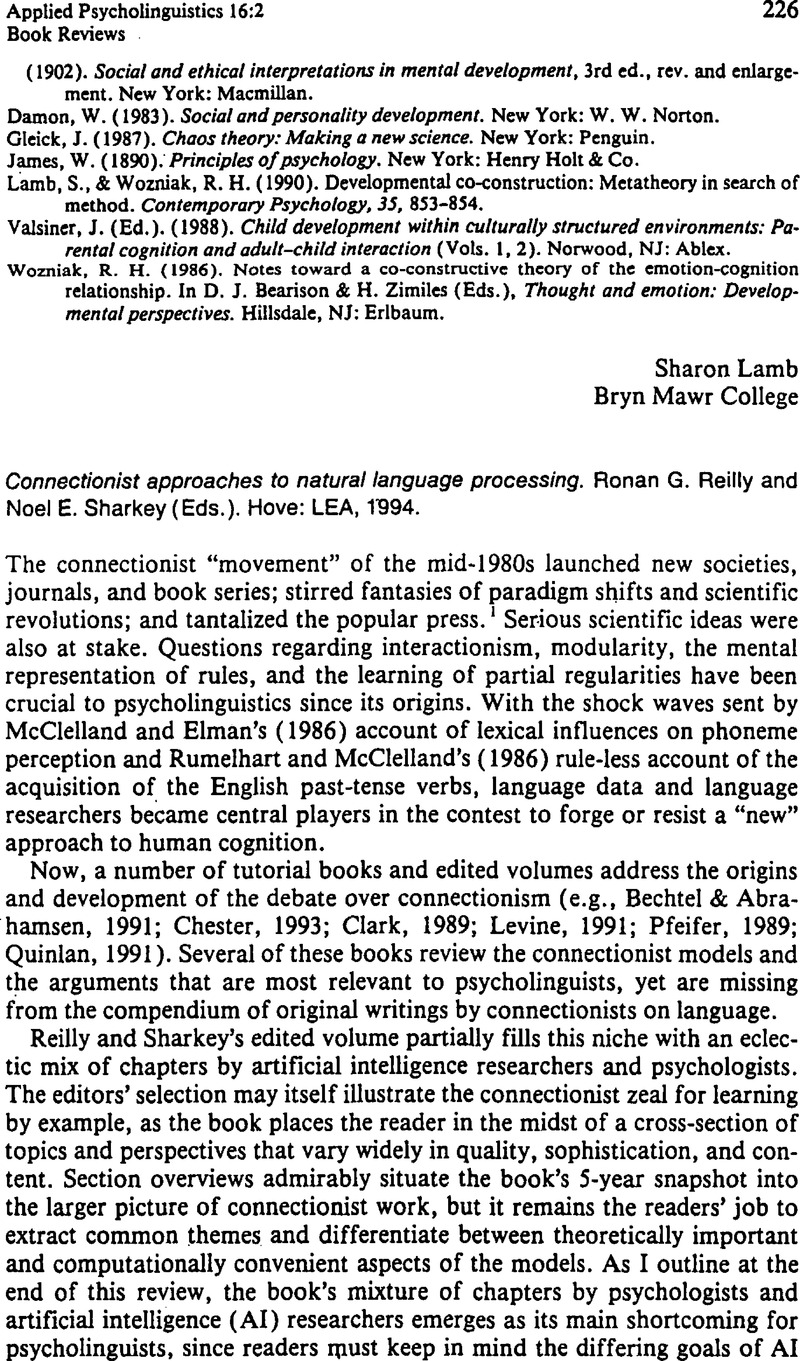No CrossRef data available.
Article contents
Connectionist approaches to natural language processing. Ronan G. Reilly and Noel E. Sharkey (Eds.). Hove: LEA, 1994.
Published online by Cambridge University Press: 28 November 2008
Abstract
An abstract is not available for this content so a preview has been provided. Please use the Get access link above for information on how to access this content.

- Type
- Book Reviews
- Information
- Copyright
- Copyright © Cambridge University Press 1995
References
REFERENCES
Bechtel, W., and Abrahamsen, A. (1991). Connectionism and the mind: An introduction to parallel processing in networks. Cambridge: Basil Blackwell.Google Scholar
Brooks, R. A. (1991). New approaches to robotics. Science, 253, 1227–1232.CrossRefGoogle ScholarPubMed
Chester, M. (1993). Neural net works: A tutorial. Englewood Cliffs, NJ: Prentice-Hall.Google Scholar
Churchland, P. M. (1989). A neurocomputational perspective: The nature of mind and the structure of science. Cambridge, MA: MIT Press.Google Scholar
Churchland, P. S., Sejnowski, T., & Ramachandran, V. S. (forthcoming). A critique of pure vision. In Large scale theories of the brain. Cambridge, MA. MIT Press.Google Scholar
Clark, A. (1989). Microcognition: Philosophy, cognitive science, and parallel distributed processing. Cambridge, MA: MIT Press.Google Scholar
Cleeremans, A. (1993). Mechanisms of implicit learning: Connectionist models of sequence processing. Cambridge, MA, MIT Press.CrossRefGoogle Scholar
Elman, J. L. (1990). Finding structure in time. Cognitive Science, 14, 179–211.CrossRefGoogle Scholar
Elman, J. L. (1993). Learning and development in neural networks: The importance of starting small. In Umilta, C. & Moscovitch, M. (Eds.), Attention and performance XV: Conscious and nonconscious information processing. Hilisdale, NJ: Erlbaum.Google Scholar
Fodor, F. A., & Pylyshyn, Z. W. (1988). Connectionism and cognitive architecture: A critical analysis. Cognition, 28, 3–71.CrossRefGoogle ScholarPubMed
Lachter, J., & Bever, T. G. (1988). The relation between linguistic structure and associative theories of language learning – A constructive critique of some connectionist learning models. Cognition. 28. 195–247.CrossRefGoogle ScholarPubMed
Levine, D. S. (1991). Introduction to neural and cognitive modeling. Hillsdale, NJ, Erlbaum.Google Scholar
McClelland, J. L., & Elman, J. L. (1986). Interactive processes in speech perception: The TRACE model. In McClelland, J. L. & Rumelhart, D. E. (Eds.), Parallel distributed processing (Vol. 2). Cambridge, MA: MIT Press.Google Scholar
McClelland, J. L., & Kawamoto, A. H. (1986). Mechanisms of sentence processing: Assigning roles to constituents. In McClelland, J. L. & Rumelhart, D. E. (Eds.), Parallel distributed processing (Vol. 2). Cambridge, MA, MIT Press.Google Scholar
Mozer, M. C. (1991). The perception of multiple objects: A connectionist approach. Cambridge, MA, MIT Press.Google Scholar
Pinker, S., & Mehler, J. (Eds.). (1988). Connections and symbols. Cambridge, MA: MIT Press.CrossRefGoogle Scholar
Quinlan, P. T. (1991). Connectionism and psychology: A psychological perspective on new connectionist research. Chicago: University of Chicago Press.Google Scholar
Rumelhart, D. E., & McClelland, J. L. (1986). On learning the past tenses of English verbs. In McClelland, J. L. & Rumelhart, D. E. (Eds.), Parallel distributed processing (Vol. 2). Cambridge, MA: MIT Press.CrossRefGoogle Scholar
St., John. (1992). The story gestalt: A model of knowledge-intensive processes in text comprehension. Cognitive Science, 16. 271–306.Google Scholar
Schneider, W. (1987). Connectionism: Is it a paradigm shift? Behavior Research Methods, Instruments, and Computers, 19, 73–83.CrossRefGoogle Scholar


